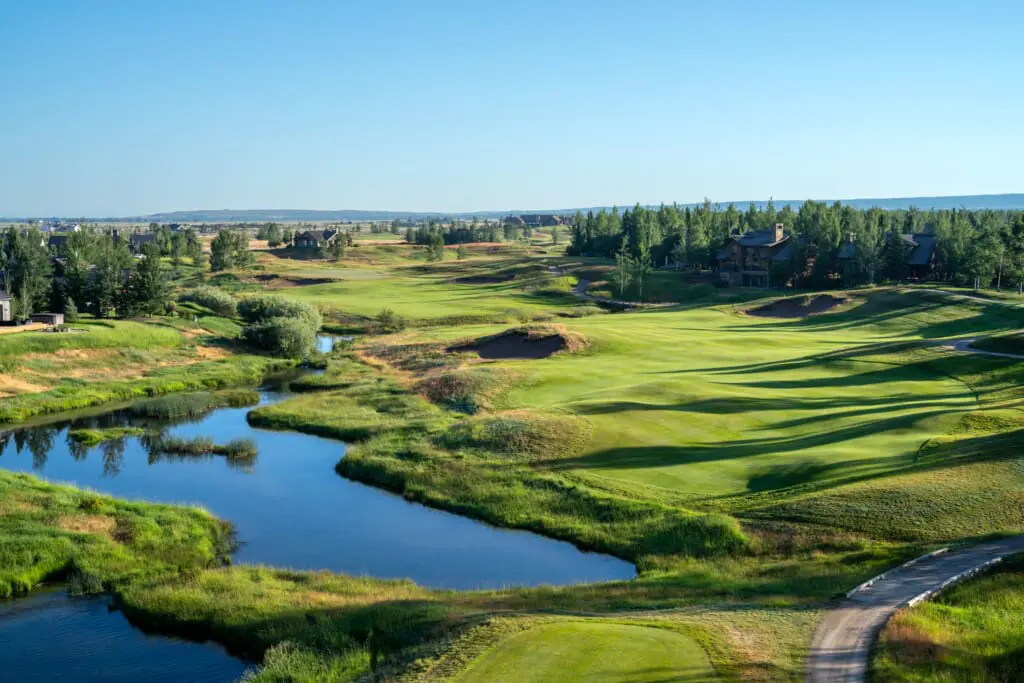FAMED SCOTTISH GOLF COURSE ARCHITECT
BEHIND BANDON DUNES ROOTING FOR RODEO DUNES
Touching down at the Jackson Hole Airport on the border of Wyoming and Idaho in Grand Teton National Park, the mountains loom large. In a world best known for its skiing and fly fishing, golfers are beginning to journey here for the Tributary Golf Course, the latest project from the famed Scottish golf course architect David McLay-Kidd, DMK, of DMK Golf Designs.
Just over the massive mountain range that jut nearly 14,000 feet into the high-altitude blue skies sits Tributary in Driggs, Idaho, a 10-hour drive from Denver. The hidden gem is a private, residential community that offers skiing, fishing, dining, wellness, and a championship golf course designed by DMK. DMK is best known for his award-winning courses at Bandon Dunes and the Castle Course at St. Andrews. McLay-Kidd is renowned for working with natural landscapes-rather than against them-to seamlessly integrate his courses into communities. While exploring Tributary, I chatted with DMK about how he approaches designing golf courses and his thoughts on Colorado’s new Rodeo Dunes by Dream Golf, which was inspired, in part, by the success of Bandon Dunes. Bandon Dunes runs along Oregon’s rugged coast with long fairways and rolling grassy dunes that flank the sea. It is an homage to Scotland’s ancient links golf and Colorado is set to get its version of this style of course.
Rodeo Dunes is a new public golf course in Weld County on 4,000 acres of dunes developed by Michael and Chris Keiser, owners of Sand Valley Resort. Bill Coore and Ben Crenshaw, architects of the first of six-planned Rodeo Dunes courses, are at work with the complex expected to be open to the public in 2026. DMK is rooting for Rodeo Dunes success in hopes that he can eventually design a course there too.
“I hope it (Rodeo Dunes) crushes it because if it is going to be the next Bandon Dunes, then it is going to have a David McLay-Kidd golf course on it at some point,” DMK said. “I hope the Keiser boys give me a call and say, ‘Hey last time you went first, this time you are going third.’ If it is as success ful as everything else they touch there’s a good chance at some point down the line that I will get a shot at (designing) something.”
If this were a decade ago, DMK said he would have been begging the Keisers for a chance to work n Rodeo Dunes, but today he is so busy building courses he can patiently wait for an opportunity to work with Dream Golf again.
Rodeo Dunes is fully focused on the first two courses for the time being, but Tom Ferrell, Rodeo Dunes VP of Media & Communications, said there is room for more golf on the site.
“Al of the current attention is on introducing the C&C (Coore and Crenshaw) course to Colorado golfers for the 2026 season,” Ferrell said in an
email.
While DMK has yet to see the Colorado property in person, he can envision what the terrain looks like and said it is hands down the best inland terrain for golf. The rugged eastern plains of Colorado make for ideal dunes golf-akin to the southwest coast of Ireland.
The aim is to create a world-class golf course destination similar to what made Bandon Dunes and Sand Valley two of the world’s top golf destinations. Bandon Dunes proved that you can build a golf course anywhere in the U.S. and that golfers will make the journey to play it. DMK points to Sand Valley in Wisconsin and Streamsong in Florida as similar courses that have become destinations for golfers. “Bandon Dunes proved that geographical location inside the U.S. is immaterial. If the golf is really good, they (golfers) will find a way,” said DMK.
While DMK’s most popular courses share the “dunes” or “links” designation, he is uncomfortable with being put in a box using such terms. He
just tries to create courses that celebrate golf’s ground game.
“What Americans see is golf courses that appreciate or celebrate the ground game in whatever way we create them,” he said. “Whether they look linksey or dunesy, we are trying to make the game more multi-dimensional than it appears on the current PGA tour.”
When designing a course, DMK looks at the raw potential of landscapes viewing such places as a script that he both directs and produces to create the best course possible. The trick to getting a dunes course right, including his recent work on Tributary, has less to do with creating a dream course and more to do with seeing what the land has to offer. DMK said some sites, such as Bandon Dunes, are a perfect site for golf as is. However other sites such as Tributary require more work.
The trick to getting a dunes or links course right, is what DMK calls a “Golf Time Machine” – he approaches a tract of land by looking to the past before creating the future. He tries to envision what the landscape looked like billions of years ago and then creates that world with his course design.
Rodeo Dunes and Tributary are both great examples as the landscape and fairways prove that sometimes restoring an ancient landscape is better than creating a new one. DMK said that over his expansive career designing golf courses, he has learned all the tricks and has every tool available to him at this point, yet less is more when it comes to golf course design. “Brevity and minimalism and restraint are now the things I value the most,” DMK said.
